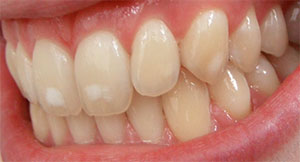What Is It?

Dental fluorosis is damage to the teeth caused by the consumption of too much fluoride while the teeth are forming. Fluorosis most commonly affects the adult teeth because they form at the pivotal time when a child begins using a fluoridated toothpaste for the first eight years of life. Once the teeth are formed and erupt into the mouth, they are no longer susceptible to fluorosis.
What Does It Look Like?
Teeth will appear mostly mildly discoloured. The teeth might have white, yellow or brown notches, lines or indentations on them. The enamel will be fairly pitted and rough in nature, and there will be surface irregularities.
How Common Is Fluorosis?
Fluorosis first caught attention in the 20th century due to high levels of naturally occurring fluoride in the drinking water in Colorado Springs. It was noticed that there was a correlation between these types of fluoride stains and a very low number of cavities. Therefore fluoride began being introduced into the drinking water of other communities. It is observed that nearly 1 in 4 people have mild markings of fluorosis, which is prevalent in youth.
Causes of Fluorosis
The most prevalent cause of fluorosis is the overuse and consumption of fluoride-containing products such as toothpaste and mouth rinse. Children should be observed while brushing their teeth and rinsing with fluoride mouth rinse until at least six years old to make sure they don’t swallow or eat the products. Also, overexposure to fluoride via drinking water and supplements can also cause fluorosis. Fluoride supplements or tablets are important in communities that don’t have access to fluoride drinking water but shouldn’t be used in communities that do.
Treatment for Fluorosis
In most cases, the signs are very mild and don’t require any treatment. In cases where the fluorosis is moderate to severe, several options may be taken to improve the aesthetic appearance of the teeth, as well as eliminate the risk of chipping and breaking. These treatment options include dental fillings, dental bonding, dental crowns, dental veneers and teeth whitening.
If you are unsure how much fluoride your child should be exposed to, or unsure when to start using fluoride-containing products with them, or if you believe your child may be showing signs of fluorosis, we encourage you to contact us today to schedule an appointment.
